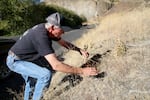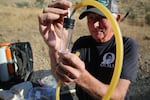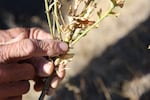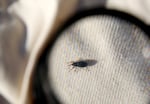
Retired Gilliam County noxious weed chief Don Farrar looks for invasive Toadflax in 30 Mile Canyon, September 2022.
Kristian Foden-Vencil / OPB
Managing weed growth in Oregon is like painting the Golden Gate Bridge in California — it’s a job that never ends.
And no — not that kind of weed. While cannabis sales bring in money for the state’s coffers, invasive weeds like Toadflax, Medusa head and Cheatgrass cost Oregon more than $80 million a year. They choke out native species and don’t make good food for animals.
If those weeds were left to their own devices, losses would mount to $1.8 billion, according to the Oregon Department of Agriculture.
Back in the 1970s and 1980s, Oregon’s farmlands were hit by a nasty new weed called tansy ragwort. When cattle and horses ate enough, alkaloids in the ragwort cause liver damage and death.
To save its dying livestock, Oregon created a new Noxious Weed Program
Ever since, people like Don Farrar, 66, have spent their careers finding and rooting out noxious weeds. The lifelong rancher just retired as head of Gilliam County’s noxious weed program. To give a sense of the scope of his department’s work, he explained what it took to control just one of the 130 weeds on Oregon’s list of noxious plants.

Don Farrar uses a bug catcher to catch bugs so they can be taken and placed on weeds elsewhere. September 2022
Kristian Foden-Vencil / OPB
“Toadflax had been here for years,” he said, leaning over his pickup in Condon on a dry September day, “It was just gradually taking over everything and getting worse and worse and worse. Farmers were using more harsher chemicals to try to control it. And they weren’t really keeping up with it. And neither were we.”
Dalmatian Toadflax was first noticed in Oregon in the early 1900s. It’s thought to have come from Europe in the ballast of ships. Farmers started just pulling it out by the roots. But that’s exhausting and relatively ineffective. After World War II, herbicides came into widespread use. The trouble was, they were crude and killed all manner of plants, not just toadflax.
Over time, however, herbicides became more focused and Farrar remembers spending $100,000 to hire a helicopter for a week to spray Gilliam County’s steep canyons. The herbicides worked well enough, but environmental laws meant they couldn’t spray within 50 feet of a stream. So the toadflax just settled in along the waterways and sent out untold millions of seeds every season.
“We were never going to get this,” Farrar said.

Mecinus bugs drill into Dalmatian Toadflax to lay their eggs. September 2022
Kristian Foden-Vencil / OPB
Then back in the 2000s, he found a technical journal that suggested killing it with a bug from Europe. The bug is called Mecinus Janthinus and it drills into the stem of toadflax — and only toadflax — to lay eggs for its larvae.
But there was a problem. One bug cost $500. And they were hard to find.
“They were new and there was nobody that really had them,” he said.
Still, with a $50,000 grant from the Oregon Department of Agriculture, Farrar bought 100 bugs from a supplier in Idaho. Trouble was, sprinkling $500 bugs out in the open and then informing the state of their whereabouts, pretty much guaranteed the pricey critters would get poached.
“It was disappointing that as soon as we got established, we had sellers come in and take some,” Farrar said.

Mecinus Janthinus bugs were introduced to tackle Toadflax blooms.
Kristian Foden-Vencil / OPB
He decided to only tell the state about one bug placement site — along 30 Mile Canyon. The other site, along the John Day River, he kept to himself.
And it worked. The bugs gobbled up most of the toadflax along both rivers and left native species alone.
Now, Farrar says when toadflax booms — as it does now and then — there’s a subsequent boom in the Mecinus bug population, which naturally brings the toadflax back under control.
That day in September, Farrar looked up 30 Mile Canyon into a sea of native sage bunchgrass and larkspur. He thinks keeping the site secret, just for a while, was a good idea.
“Within the next couple of years, we had enough (bugs) for basically everybody in the state that wanted any,” he said.
So that’s one weed success story. But Oregon’s Noxious Weed Program has also faced challenges in recent years. For one thing, the earnest young people, like Farrar, who signed up for careers at the agency in the ‘70s and ‘80s are now retirement age.
“I said three years ago to the leaders in this agency, that we had 57 people at that point in time that could walk out the door for retirement,” said Lauren Henderson, the interim director of the Oregon Department of Agriculture. “It’s happening.”

“I said three years ago to the leaders in this agency, that we had 57 people at that point in time that could walk out the door for retirement. It’s happening,” said Lauren Henderson, the Interim director of the Department of Agriculture.
Kristian Foden-Vencil / OPB
On top of all the retirements, funding has become an issue. The program is paid for largely by the state lottery. But the cafes and bars where lottery machines stand just weren’t open during the pandemic, so there was hardly any money.
Henderson said he either had to fire everyone in the weed program or find them work elsewhere.
So during COVID, the state’s weed experts changed gears and worked on a different kind of weed — cannabis.
The state wanted to make sure Oregon’s hemp farmers weren’t growing cannabis with the hallucinogenic compound THC if they didn’t have a permit for it.
But Henderson says his employees have now stopped focusing on weed, the drug, and are again battling weed, the invasive plant.

Oregon Department of Agriculture entomologist, Joel Price, is one of the younger employees. He's pushing the boundaries of weed-fighting to include pathogens – so using things like fungus and nematode worms as well as bugs. September 2022
Kristian Foden-Vencil / OPB
And not all bug enthusiasts are silver-haired ranchers. Entomologist Joel Price is just 37. And he said there are a number of new ideas that are coming in with younger staff. For example, the program used to collect bugs in the wild, so they could be transferred to areas where a weed is blooming.
Now, they find it’s more efficient to collect only a few bugs in the wild, about 70, then put them in a growth chamber. A grow chamber looks like a fridge but inside it simulates long daylight hours, warm temperatures and plenty of food. After a couple of weeks, 70 bugs in a grow chamber can turn into 7,000 bugs that can then easily be distributed.
“It’s become kind of difficult to predict where and when bugs are going to be collectible across the whole state, with these wild climactic events and things,” Price said. “So, rearing them in a laboratory is much more controlled and predictable.”

Oregon Agriculture department entomologist Joel Price checks on the growth of bugs in a lab growth chamber. November 2022
Kristian Foden-Vencil / OPB
Price said the program is also pushing the boundaries of weed-fighting bugs to include weed-fighting pathogens. Such pathogens would include fungi and nematode worms.
There are some people who don’t like to see the introduction of foreign species or herbicides used for weeds, but many environmental groups support Oregon’s weed program.
Mark Salvo with the Oregon Natural Desert Association said herbicides might not be the association’s first choice, but the noxious weed problem is so bad they’re willing to consider all tools, “And sometimes that can include the use of herbicides,” Salvo said.
When Lane County announced a plan to spray roadways, the local chapter of the Native Plant Socien of Oregon released a statement acknowledging that herbicides may have a role in vegetation management.

Retired Gilliam County noxious weed chief Don Farrar with his pickup and equipment. “The toadflax had been here for years. It was just gradually taking over everything and getting worse, and worse and worse. And the farmers were using more harsher chemicals to try to control it. And they weren’t really keeping up with it, and neither were we.” September 2022
Kristian Foden-Vencil / OPB
Back in Gilliam County, Don Farrar explains a weed is just a plant that we’ve decided is out of place. And one of the main ways weeds get around is by road. Branches can hitch a ride in a vehicle’s undercarriage or seeds can fall into a convenient bumper curve.
“Cars carry weeds,” Farrar said. “It only takes picking up one tumble mustard and taking it to the next county to move it there.”
Spraying along the roads of Gilliam County starts now, in the late fall before it snows, so moisture can carry the herbicide into the soil. That way, when weeds try to grow in the spring, germination is blocked.

Entomologist Joel Price checks on some weeds that he's using to feed a growing bug population. November 2022
Kristian Foden-Vencil / OPB
